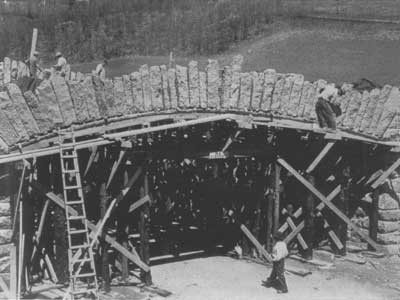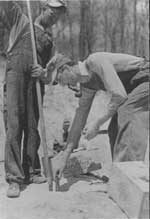 | ||
 | ||
 | ||
 | ||
 | ||
 | ||
 | ||
 | ||
 | ||
 | ||
 | ||
 | ||
 | ||
 | ||
 | ||
 | ||
 |
 |
 |
Blue Ridge Parkway
Virginia and North Carolina

Erecting stone facing for a bridge, 1935. |
CONSTRUCTION BEGINS
The project's authorization specified that the states would purchase the land for the parkway and the federal government would build the road. Following final field surveys, state land officers purchased the land for the right-of-way.
On September 11, 1935, construction of the first 12.5-mile section began near Cumberland Knob in North Carolina. Work in Virginia began the following February. The parkway was not constructed as one continuous project, but instead was divided into 45 separate construction units. This approach was necessitated by delays in acquiring land, but it also enabled parkway contractors to hire more people to work at the same time.
For its first three years, the project existed under the authorization issued by Ickes in his role as federal public works administrator. For want of a better name, the project was generally called the "Appalachian Scenic Highway." Mountain folk watching its early construction abbreviated this to "The Scenic." On June 30, 1936, Congress formally authorized the establishment of the "Blue Ridge Parkway" and placed it under the jurisdiction of the National Park Service.
NEW DEAL WORK PROGRAMS

Packing explosives while smoking a pipe, ca. 1935. |
While most construction was carried out by private contractors, a variety of New Deal public works programs played important roles in the parkway's development. Some roadway construction was carried out by the Works Progress Administration. The purpose of the WPA was to put as many men to work as possible, so hand labor was used extensively, even when power equipment might have been more efficient. WPA crews cleared brush, drilled rock with hand drills for blasting, and performed other manual labor. Pay was low—$55 a week in the beginning—but the income was a godsend for many mountain families. Another New Deal program utilized by the parkway was the Emergency Relief Administration. ERA crews carried out landscape work and development at parkway recreational areas. The best-known public works program was the Civilian Conservation Corps. Four CCC camps were established on or adjacent to the parkway, and their crews of young men toiled at roadside cleanup, planting, grading slopes for scenic effect, and improving roadside fields and forests.
Most relief programs were disbanded with the outbreak of World War II. During the war, some landscape and park development work was carried out by conscientious objectors organized under the Civilian Public Service program. In recent years, Student Conservation Association and Youth Conservation Corps workers have completed valuable projects.
| Introduction | Acadia | Blue Ridge Parkway | Colonial Parkway | Generals Highway | George Washington Memorial Parkway | Great Smoky Mountains | Mount Rainier | Rock Creek and Potomac Parkway | Shenandoah's Skyline Drive | Southwest Circle Tour | Vicksburg | Yellowstone | Yosemite | Discover History |
